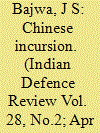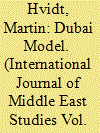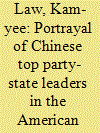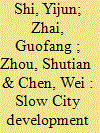| Srl | Item |
| 1 |
ID:
119369


|
|
|
| 2 |
ID:
090266


|
|
|
|
|
| Publication |
2009.
|
| Summary/Abstract |
The developmental process as it unfolds in Dubai has hardly been analyzed by academics. Most current knowledge about the country originates from media coverage, especially from news magazines and business literature. Recently a number of social science based but historically oriented academic publications have appeared. Only one study, however, has seriously sought to place Dubai in a broader developmental framework: Sampler and Eigner's From Sand to Silicon, published in 2003. Yet, by applying the so-called strategic trajectory model to the case of Dubai, they reduce their focus to the management side. Their aim is too narrow to provide an explanation of the overall development process in Dubai.
|
|
|
|
|
|
|
|
|
|
|
|
|
|
|
|
| 3 |
ID:
092417


|
|
|
|
|
| Publication |
2009.
|
| Summary/Abstract |
The three decades of "world-shaking" reform and the opening up are believed to have brought enormous changes to China. Today, few can deny China's crucial position in the global economy. However, aside from the obvious economic changes, it is uncertain whether the previously mysterious, untouchable and reclusive China thoroughly reformed itself from the demonized character during the globalization trend and years after the Cold War. Today, when 'national image becomes an important part in soft power competition among countries...and a very significant strategic issue China faces in the development process', this article aims at examining the scope and specific 'frames' that American mainstream news media use to report on China's party-state leaders over the past 3 decades. Through the contents analysis of Time and Newsweek, the study finds that the image of China's party-state leaders has not been drastically different under the framing. Since the judging criteria for the American mainstream news media towards political leadership has not significantly changed, they would still show certain disapprovals to the political aspects of China not change at all even after thirty years reform.
|
|
|
|
|
|
|
|
|
|
|
|
|
|
|
|
| 4 |
ID:
167054


|
|
|
|
|
| Summary/Abstract |
The Slow City concept advocates the development of cities by combining modern technologies and traditional lifestyles to provide efficient transportation and communication and high quality of life for the residents. This study investigates the present situation, development approach and public acceptability of the Slow City concept in China. Based on the theory and the practical application of the Slow City concept in major member countries, the development process of Slow City can be divided into three stages: the origin stage, the development stage and the promotion stage. This study shows that the Slow City development in China is at the third stage. Due to diverse economic foundations, cultural traditions and the sociopolitical environment, the Slow City in China represents different features compared to the Slow City in Europe. A systematic analysis provides a better understanding of the situation of the Chinese Slow City. Then, the authors evaluate the degree of acceptability of the Slow City concept in China based on three aspects: the understanding, the awareness, and the popularity of the Slow City. Based on the results, this paper suggests optimistic growth opportunities for the Slow City in China and provides several strategies with regard to diverse perspectives.
|
|
|
|
|
|
|
|
|
|
|
|
|
|
|
|